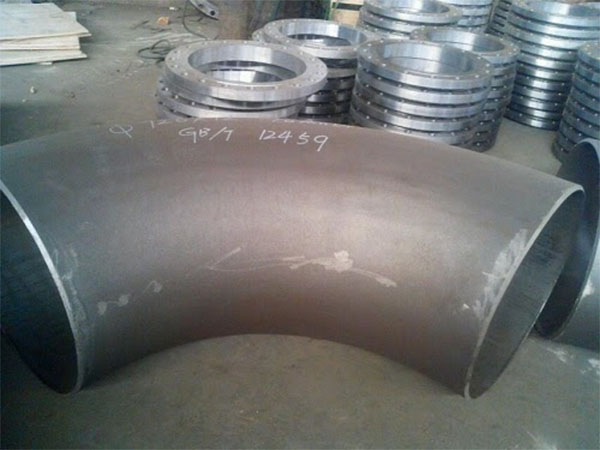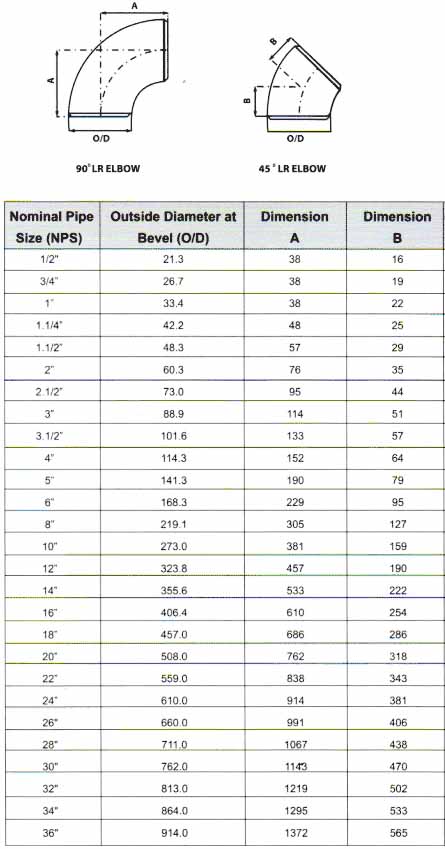Elbows are pipe fittings used in
pipeline systems to change the direction of fluid or gas transportation. They can be classified into different angles such as 45°, 90°, 135°, and 180° according to their angles. Among them, 45° elbows and 90° elbows are the two most common angles. They differ in structure, performance, installation space and application, etc. Understanding the differences between them can help customers choose elbows that meet the project requirements.
What are 45° elbows and 90° elbows?
A 45° elbow is an elbow that connects two steel pipes at a 45° Angle, and a 90° elbow is an elbow that connects two steel pipes at a 90° Angle. A 45° elbow can change the direction of a pipe by 45°. Its bending radius is usually 1-2 × the pipe diameter (R = 1D or 1.5D, 2D, etc.). Common standards include short radius (SR, R = 1D) and long radius (LR, R = 1.5D or 2D).
A 90° elbow can change the direction of a pipe by 90°. It also comes in two types: short radius (R = 1D) and long radius (R = 1.5D, 2D, etc.).

The most significant difference between the two types of elbows lies in the bending Angle. Other differences include fluid resistance and pressure, space requirements, installation difficulty, and application. Here, I will elaborate on these in detail for you:
The difference in bending angles: The 45° elbow has a smaller bending Angle, making the turn more gentle and the flow rate more stable, which helps to reduce the impact and wear inside the pipeline. The 90° elbow has a right-angle bending Angle, a relatively sharp bending Angle, and a small radius. It is suitable for environments with limited space and strong fluid impact force.
The difference between fluid resistance and pressure: The pressure loss of a 45° elbow is relatively small, approximately only half that of a 90° elbow. Moreover, when two 45° elbows of the same radius are used in conjunction, the pressure loss is equivalent to that of a single 90° elbow. The pressure loss of the 90° elbow is relatively large. Due to its right-angle structure, when the fluid passes through, the velocity on the inner bending side is concentrated, which is prone to form secondary flow. Under the same pipe diameter and radius conditions, the resistance coefficient of a 45° elbow is approximately 0.2 to 0.3, while that of a 90° elbow is about 0.6 to 1.0. The specific values depend on the flow velocity and the radius of curvature.
The difference in spatial requirements: A 45° elbow has a smaller turning Angle and requires a slightly longer horizontal or vertical space. However, two 45° elbows with the same radius can also be combined to form a 90° elbow, thereby achieving a larger radius and a smoother transition. The 90° elbow has a large turning Angle and occupies the shortest distance along the way, making it suitable for applications with limited space.
The difference in installation difficulty: Using a 90° elbow is faster, cheaper, safer to install than two 45° elbows, with fewer connections and a lower risk of leakage.
The difference in application fields: 45° elbows are suitable for HVAC, chemical processing, and systems that require smooth flow transitions. The 90° elbow is suitable for pipelines with limited space and is often used at the bifurcation point between the pipeline and the main line.
A comparison chart of the dimensions of 45° and 90° elbows

Summary and suggestions
Give priority to using 90° elbows: They have a simple structure, quick installation, and a relatively low price, making them suitable for most scenarios.
When pressure reduction or wear prevention is required: Choose 45° or long radius elbows. A smoother flow direction can reduce impact.
Under spatial constraints, the flow rate still needs to be optimized: a long radius of 90° can be used. If the direction of the pipeline needs to be adjusted particularly, it can be flexibly combined at 45° for use.

